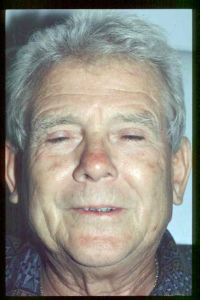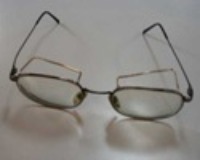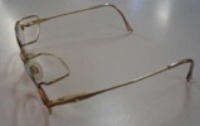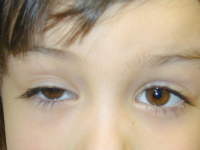|
What is a Ptosis?
Have you noticed one or both of your upper eyelids drooping down covering part or all of your eye(s)? Has this happened to you recently? Or were you born with one upper eyelid lower than the other as visible in old childhood pictures? You have Eyelid Ptosis. 
This can happen to anyone, both young and old. It can be congenital (meaning you were born with it) or acquired (either from a disease or from trauma or simply from advancing age). Naturally, it will be more bothersome to those who get it later in life in terms of the cosmetic impact and the visual symptoms.
For those who are born with it, they usually have adapted and perhaps only have cosmetic concerns. However, this can be associated with Amblyopia if the upper eyelid droops low enough to cover the visual axis early in childhood. If during the critical period of development (under six years of age) the child cannot see out of the obstructed eye because of the Ptosis, then the proper connections are not made from the eyeball to the brain and that eye will have decreased vision compared to the other one. Sometimes people refer to Amblyopia as Lazy Eye. Sometimes the problem is not with the levator muscle. If the forehead muscles (known as the frontalis muscles) are paralyzed, the levator muscle will have a greater workload in trying to lift the upper eyelid up. If it cannot lift the eyelids, then you have Ptosis of the brow. What are signs and symptoms?
What are causes?
The causes depend on many factors. For example, does yours involve one eye or both eyes? Having in only one eye often stems from neurological or mechanical disease, whereas if it affects both eyes, it is typically associated with generalized muscle disorders or aging. Your eye doctor will also look at associated signs. For example, is your pupil affected? Pupil involvement can point to a disease like Horner’s Syndrome, which involves one eye with a constricted pupil (known as miotic pupil). Suppose you are diabetic and you get a third nerve palsy as a complication of your condition. You may notice that your Ptosis is accompanied by a restriction of upgaze and adduction (that is, bringing the eye in toward the nose). In some cases of third nerve palsy, your pupil may be dilated and unresponsive to light. Do you have pain and swelling of the lid? You may have an inflammatory condition or perhaps it is a growth (like a cancerous lesion). Is yours constant or variable? If it is variable, you may have a condition like Myasthenia Gravis. This has also been found to be a complication of frown correction by botulinum toxin, also known as Botox. How is this diagnosed?
The diagnosis is going to depend on a good discussion between your eye doctor and you about your symptoms and his or her assessment of any associated signs. A routine eye exam will be able to reveal most causes although further medical and/or laboratory testing may be necessary when an underlying cause other than age is suspected. The most common type is usually age-related, referred to as Aponeurotic Ptosis or Involutional Ptosis. While this form primarily affects elderly patients, younger patients can develop this condition as a result of trauma, severe lid swelling, prior ocular surgery or long-term contact lenses wear. How is it treated and managed?
If you have acquired Ptosis, determining the underlying cause is the most important aspect of managing your condition. If you have Aponeurotic Ptosis, you have a variety of treatment options which may include: 

You should feel the tension of the eyelids trying to open against the resistance of your fingers. Hold for 5-6 seconds and then release. Repeat this 10-20 times every day. You should do these exercises for a few months before you get noticeable results. The procedure consists of a skin incision of the upper eyelid crease for the entire length of the eyelid. In a select group of patients, a less invasive approach with an upper lid skin incision of only 0.8 cm is equally effective and offers several advantages such as the use of a single stitch to suture the levator to the tarsal plate results in a natural contour of the eyelid margin, less local anesthetic in the eyelid quickens the postoperative recovery, less swelling after surgery is ideal because it reduces the risk of post-operative drop of the operated eyelid, and saves surgical time. |





